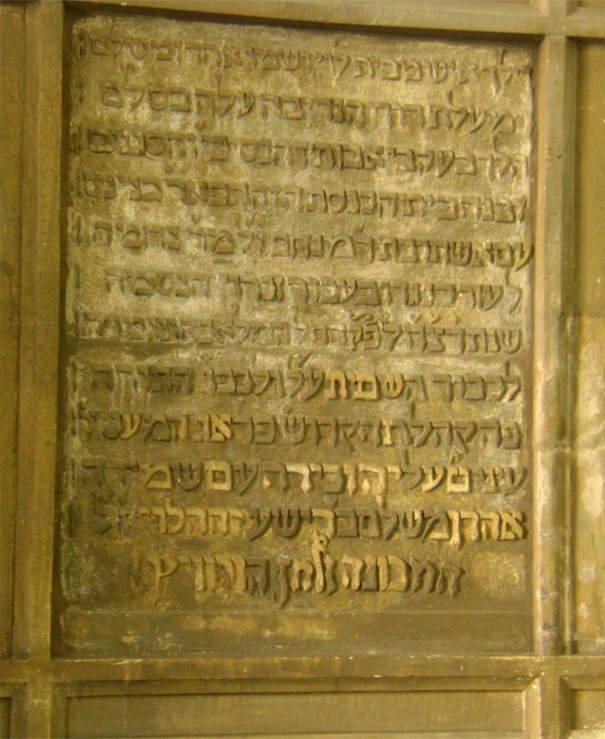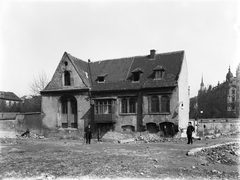
Pinkas Synagogue Visiting Hours, Tickets, and Complete Guide to Prague’s Historic Jewish Sites
Date: 15/06/2025
Introduction
Located in Prague’s historic Jewish Quarter (Josefov), the Pinkas Synagogue is a deeply significant memorial, architectural monument, and educational site. Built in the 16th century, it stands as the second oldest preserved synagogue in Prague and has witnessed centuries of Jewish life, tragedy, and resilience. Today, its walls are inscribed with nearly 80,000 names of Holocaust victims from Bohemia and Moravia, transforming the synagogue into one of Europe’s most powerful Shoah memorials. The site also features an evocative exhibition of children’s drawings from the Terezín Ghetto, and a rare historical mikveh, offering a layered and moving experience for visitors.
This guide provides all the essential information for planning your visit, including history, architectural highlights, memorial exhibitions, ticketing, visiting hours, accessibility, and recommended nearby attractions. Whether you seek historical understanding, personal reflection, or cultural exploration, the Pinkas Synagogue is an unmissable destination in Prague’s Jewish Quarter.
For official information and updates, consult the Jewish Museum Prague, Prague Guide, and Prague.org.
Contents
- History and Origins (15th–16th Centuries)
- Architectural Evolution (17th–19th Centuries)
- The 20th Century: War, Memorialization, and Suppression
- The Pinkas Synagogue Today: Memorial, Museum, and Community
- Visiting Information: Hours, Tickets, and Accessibility
- Travel Tips and Nearby Attractions
- Visuals and Interactive Resources
- FAQ
- Key Dates and Figures
- Historical and Cultural Significance
History and Origins (15th–16th Centuries)
The Pinkas Synagogue traces its roots to a small prayer hall existing before 1492, within the “Coats of Arms House” in Josefov. In 1519, Aaron Meshulam Horowitz, a leading figure in Prague’s Jewish community, became sexton and commissioned the current synagogue, completed in 1535 (Jewish Museum Prague). Its name likely derives from Israel Pinkas, the original owner of the house, or Rabbi Pinkas Horowitz, Aaron’s grandson. The synagogue originally served as a private place of worship for the prominent Horowitz family and features late Gothic and early Renaissance elements, including intersecting stone ribs, a carved stone Holy Ark, and a late 15th-century mikveh (Jewish Museum Prague; Avantgarde Prague).
Architectural Evolution (17th–19th Centuries)
The synagogue endured repeated flooding due to its low elevation near the Vltava River, necessitating major renovations. After a devastating fire in 1689 and a significant flood in 1860, the interior was modernized—raising the floor, backfilling the bimah, and removing Baroque decorations. In the late 19th century, it was rebuilt in the neo-Gothic style, reflecting contemporary tastes. The urban renewal of Josefov (1907–1910) demolished surrounding buildings and raised street levels, leaving the synagogue below the current street surface (Jewish Museum Prague; View from Prague).
The 20th Century: War, Memorialization, and Suppression
Pre-War and Wartime Use:
Before World War II, Pinkas Synagogue remained a vibrant religious center. The Nazi occupation from 1939 and the Holocaust decimated Prague’s Jewish community, with nearly 80,000 Jews from the Czech lands murdered (Jewish Museum Prague).
Transformation into a Holocaust Memorial:
In the postwar years, the synagogue was restored and, between 1955 and 1960, became one of the earliest Holocaust memorials in Europe. Artists Václav Boštík and Jiří John inscribed almost 80,000 names of Bohemian and Moravian Jews on its walls, organized by community, date of birth, and last known information. The memorial’s solemn design turns the synagogue into a powerful space of collective mourning (Avantgarde Prague; Jewish Museum Prague).
Communist Era Closure and Restoration:
After the Soviet invasion in 1968, the synagogue was closed for over two decades under the pretense of technical issues but reflecting broader suppression of Jewish memory. It was not until after the Velvet Revolution and extensive restoration that the memorial reopened in 1995 (Jewish Museum Prague).
The Pinkas Synagogue Today: Memorial, Museum, and Community
Holocaust Memorial and Exhibitions
Today, the Pinkas Synagogue is administered by the Jewish Museum in Prague. The inscribed names serve as a stark reminder of the Holocaust’s devastation. On the upper floor, a permanent exhibition displays children’s drawings created in the Terezín Ghetto under artist Friedl Dicker-Brandeis, testifying to the hopes and resilience of the children, most of whom did not survive (Jewish Museum Prague).
Temporary exhibitions and outdoor displays expand the memorial’s educational role, using digital kiosks, maps, and projected photographs to further contextualize the tragedy (Jewish Museum Prague).
The Ritual Bath (Mikveh)
A late 15th-century mikveh, rediscovered in 1968, is accessible via guided tours (except Saturdays). It remains in use by the Prague Jewish community and offers visitors insight into Jewish ritual life (Avantgarde Prague).
Community and Preservation
The synagogue’s proximity to the Old Jewish Cemetery and other historic synagogues situates it at the heart of Prague’s Jewish heritage. Its resilience through floods, fires, war, and political repression, and its status as a National Cultural Monument, underscore its enduring significance (Jewish Museum Prague).
Visiting Information: Hours, Tickets, and Accessibility
-
Visiting Hours:
Open Tuesday–Sunday, 9:00 AM–5:00 PM (closed Mondays and Jewish holidays). Summer hours may extend to 6:00 PM; winter hours may close at 4:30 PM. Always check the official website for updates. -
Tickets:
Entry is included in the Jewish Museum Prague’s combined ticket, covering multiple synagogues and the Old Jewish Cemetery. Approximate prices are 350 CZK (adults), 250 CZK (students/seniors/children 6–15), and 50 CZK (disabled visitors); children under 6 enter free. Tickets can be purchased online or at the museum entrance. It is not possible to purchase a ticket for the Pinkas Synagogue alone (Prague.org; Prague Visitor Pass). -
Accessibility:
The synagogue is partially accessible, but some areas (like the upper gallery) may be challenging for those with limited mobility due to the building’s historic structure. Contact the museum ahead for specific needs. -
Location:
Široká 3, Josefov, Prague. Conveniently located near Old Town Square and accessible via Staroměstská metro and nearby tram stops (Prague Guide).
Travel Tips and Nearby Attractions
- Recommended Itinerary:
Begin at the Pinkas Synagogue, then visit the adjacent Old Jewish Cemetery, the Old-New Synagogue, the Spanish Synagogue, and the Jewish Museum’s exhibitions. - Guided Tours:
Available through the Jewish Museum Prague and reputable operators, offering deeper historical context (GetYourGuide). - Best Visiting Time:
Early mornings or late afternoons on weekdays are least crowded. - Dress and Etiquette:
Dress modestly, speak quietly, and move respectfully as the synagogue is both a memorial and active religious site. - Nearby Sites:
Old Jewish Cemetery, Maisel Synagogue, Spanish Synagogue, and the Jewish Museum are all within short walking distance (PragueHere).
Visuals and Interactive Resources
High-quality images, virtual tours, and interactive maps are available on the Jewish Museum Prague website. Use SEO-optimized image alt tags such as “Pinkas Synagogue Holocaust Memorial” and “Terezín children’s drawings” for web content.
Frequently Asked Questions (FAQ)
What are the Pinkas Synagogue visiting hours?
Typically Tuesday–Sunday, 9:00 AM–5:00 PM; closed Mondays and Jewish holidays. Check the official website for seasonal changes.
How much are tickets?
Included in the Jewish Museum combined ticket: approx. 350 CZK (adults), 250 CZK (children/students/seniors), 50 CZK (disabled), free under 6.
Can I visit only the Pinkas Synagogue?
No, tickets are for the combined Jewish Museum sites.
Is the synagogue accessible for disabled visitors?
Partially; some areas may be difficult to reach. Contact the museum for assistance.
Are guided tours available?
Yes, through the Jewish Museum and private operators.
Is photography allowed?
Generally permitted, but avoid flash and respect signage or instructions, particularly near the memorial walls.
Key Dates and Figures
- Pre-1492: Site used for prayer.
- 1535: Synagogue completed.
- 1689: Damaged by fire.
- 1860: Major flood and interior modernization.
- 1907–1910: Urban renewal; street level raised.
- 1950–1954: Restoration.
- 1955–1960: Memorial inscriptions added.
- 1968–1995: Closed during Communist era.
- 1995–present: Functions as memorial and museum. (Jewish Museum Prague; Avantgarde Prague)
Historical and Cultural Significance
The Pinkas Synagogue is a testament to the endurance of Prague’s Jewish community, the tragedy of the Holocaust, and the importance of remembrance. Its memorial inscriptions, Terezín children’s drawings, and historical mikveh make it a multi-layered site of mourning, education, and cultural pride. As a National Cultural Monument, it anchors the broader Jewish heritage experience in Prague and remains a place for reflection, learning, and honoring those lost (Living Prague).
Practical Visitor Checklist
- Check official visiting hours before arrival.
- Purchase combined Jewish Museum ticket online or on-site.
- Dress respectfully; maintain a quiet demeanor.
- Allow at least 45–60 minutes for the synagogue, more if including other sites.
- Consider a guided tour for historical depth.
- Download the Audiala app for digital guides and updates.
Sources and Official Links
- Pinkas Synagogue in Prague: History, Visitor Information, and Nearby Attractions, 2025, Jewish Museum Prague
- Pinkas Synagogue Memorial, 2025, Jewish Museum Prague
- Visiting the Pinkas Synagogue Holocaust Memorial in Prague: Tickets, Hours & History, 2025, Jewish Museum in Prague
- Pinkas Synagogue Visiting Hours, Tickets, and Guide to Prague’s Historic Jewish Site, 2025, Prague Guide
- Pinkas Synagogue in Prague, 2025, Avantgarde Prague
- Pinkas Synagogue, Prague historical sites, 2025, Prague.org
For more information, download the Audiala app for guided tours and updates on Prague’s Jewish heritage. Your visit to the Pinkas Synagogue is not just a step into the past, but a tribute to memory and resilience.
























































































































































































